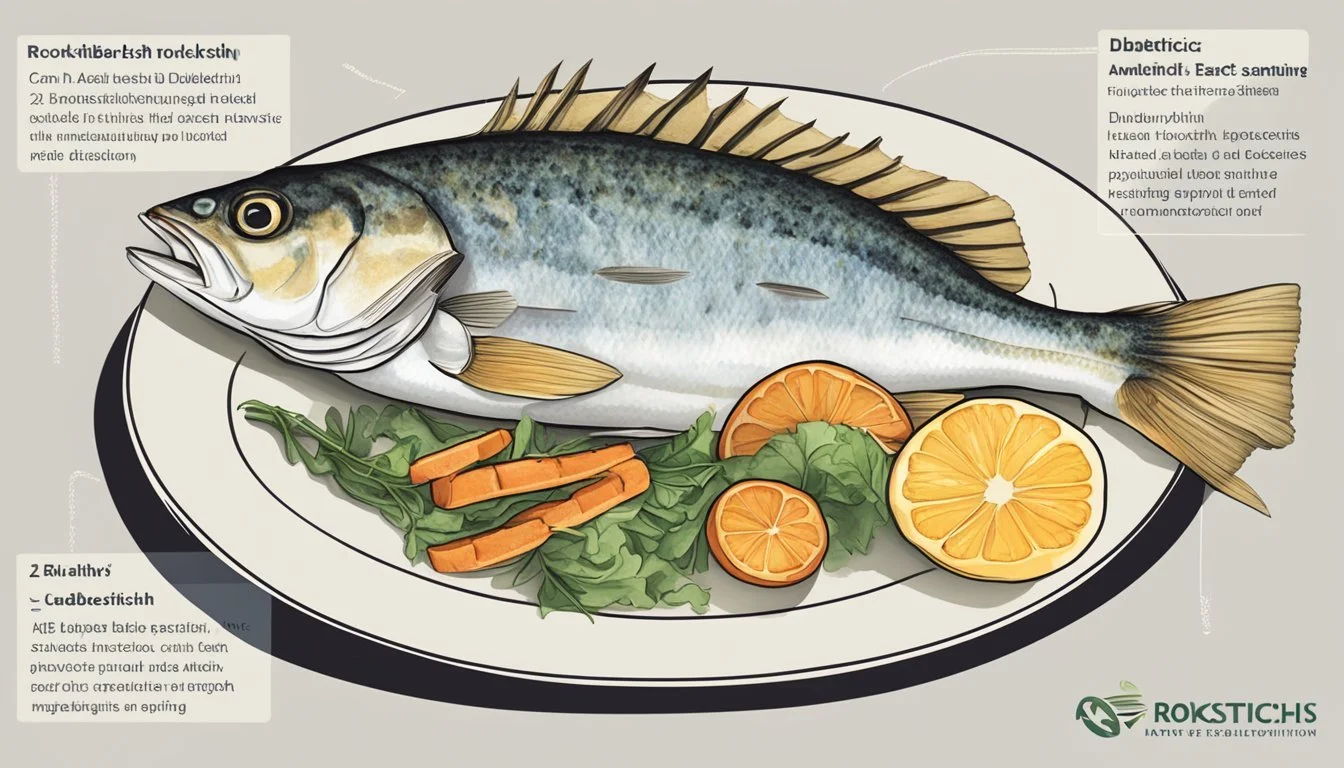Can Diabetics Eat Rockfish?
Discover Nutritional Benefits and Risks
Rockfish can be a nutritious addition to the diet of someone managing diabetes. This fish is rich in protein, which is essential for maintaining muscle mass and promoting overall health. For individuals with type 2 diabetes, rockfish offers a good source of protein without the high levels of saturated fats found in some other protein sources.
Seafood, including rockfish, plays a beneficial role in regulating blood sugar levels. Healthy fats found in various fish can help improve insulin sensitivity and glucose metabolism. However, it is important to be mindful of the source and storage of rockfish to avoid potential contaminants that could affect health negatively.
Rockfish also provides essential vitamins and minerals, supporting many bodily functions crucial for people with diabetes. By incorporating this fish into a balanced diet, individuals can enjoy a tasty and healthy meal that aids in managing their blood sugar levels effectively.
Understanding Diabetes and Dietary Needs
Diabetes management heavily relies on a balanced diet that maintains stable blood sugar levels. Key dietary principles include monitoring carbohydrate intake, choosing nutrient-dense foods, and balancing protein and fat consumption.
Role of Diet in Managing Blood Sugar Levels
Diet plays a crucial role in regulating blood sugar levels for those with diabetes. Consuming complex carbohydrates, such as whole grains and vegetables, provides a steady release of glucose, unlike simple carbohydrates found in sugary foods that can spike blood sugar.
Fiber-rich foods are especially important because they slow down the absorption of sugar, helping to maintain stable glucose levels. A diet high in fiber can also improve cardiovascular health, which is often a concern for diabetics. The American Diabetes Association recommends a varied diet that limits unhealthy fats and sugars.
Type 2 Diabetes Nutritional Guidelines
For managing type 2 diabetes, nutritional guidelines focus on balanced meals and portion control. The Diabetes Plate Method is effective for many. This involves filling half your plate with non-starchy vegetables, a quarter with lean protein, and a quarter with whole grains or starchy vegetables.
Carbohydrate counting is another valuable technique; the goal is to keep carb intake consistent at each meal to avoid blood sugar spikes. Consulting with a dietitian can help tailor these guidelines to individual needs, ensuring both nutritional adequacy and blood sugar management.
Impact of Proteins and Fats on Blood Sugar
Proteins and fats are essential components of a diabetic-friendly diet. Protein sources like lean meats, poultry, fish, and plant-based options provide necessary nutrients without causing significant increases in blood sugar. Beware of high-fat proteins such as fatty cuts of meat, which can introduce unhealthy levels of saturated fat into the diet.
Healthy fats, such as those from avocados, nuts, and olive oil, can support overall health. They can slow the digestion of carbohydrates, leading to more gradual increases in blood sugar. Avoid trans fats and minimizing saturated fats helps reduce cardiovascular risks, which are heightened in diabetics.
Effective management of diabetes involves a strategic approach to diet, emphasizing balance and nutrient-dense foods while monitoring carbohydrate, protein, and fat intake.
Nutritional Profile of Rockfish
Rockfish is a nutrient-dense fish that offers a range of essential vitamins and minerals. It is also low in calories and provides significant amounts of protein and omega-3 fatty acids, making it a suitable choice for diabetics.
Protein and Fat Content in Rockfish
Rockfish provides a substantial amount of protein, which is essential for muscle repair and growth. A typical serving of rockfish (approximately 191 grams) contains around 20 grams of protein. This high protein content can help diabetics manage their blood sugar levels effectively.
In terms of fat, rockfish is relatively lean. Each serving contains about 5 grams of total fat, including a low amount of saturated fat at roughly 1 gram. Additionally, rockfish is rich in omega-3 fatty acids like DHA and EPA, which support heart health. The fish is also low in cholesterol, contributing less than 60 milligrams per serving, making it a heart-friendly option.
Vitamins and Minerals in Rockfish
Rockfish is a good source of several essential vitamins and minerals. It is rich in vitamin D, which aids in calcium absorption and bone health. A serving of rockfish can cover a significant portion of the daily recommended intake for this vitamin.
Minerals like potassium, magnesium, phosphorus, and selenium are present in notable amounts. These minerals are crucial for various bodily functions, such as maintaining electrolyte balance, supporting bone health, and acting as antioxidants. The vitamin B complex, including B2 and B12, further enhances its nutritional profile by supporting energy metabolism and red blood cell formation.
Caloric Value and Portion Control
For those monitoring their calorie intake, rockfish offers a low-calorie option. A single fillet contains roughly 172 calories, making it suitable for those aiming to manage their weight. Given its low caloric density, diabetics can enjoy a reasonably-sized portion without the worry of excessive calorie consumption.
Portion control is key. One fillet, approximately 191 grams, is a practical serving size that helps maintain a balanced diet. It provides enough nutrition without contributing excess calories, helping diabetics keep their blood sugar levels stable. Proper portioning ensures that the nutritional benefits of rockfish are maximized while avoiding excessive intake.
The Benefits of Including Fish in a Diabetic Diet
Eating fish can offer multiple health benefits for those managing diabetes. It helps improve cardiovascular health, reduces inflammation, and provides essential nutrients that can help manage symptoms.
Omega-3 Fatty Acids and Heart Health
Fish such as salmon, mackerel, sardines, and tuna are rich in omega-3 fatty acids. These heart-healthy fats are known to reduce triglycerides, lower blood pressure, and decrease the risk of heart disease—key concerns for diabetics. Omega-3s also help maintain healthy cholesterol levels.
Studies have shown that a diet high in omega-3 fatty acids can significantly decrease the risk of cardiovascular disease. This is particularly important for diabetic patients who are more prone to heart-related issues.
Reducing Inflammation and Oxidative Stress
Chronic inflammation and oxidative stress are common among individuals with diabetes. Including fish in the diet helps to mitigate these conditions due to its anti-inflammatory properties. Omega-3 fatty acids found in fish can lower inflammation markers and improve insulin sensitivity.
Selenium and vitamin D present in fish also contribute to reducing oxidative stress, protecting cells from damage. This, in turn, supports overall health and helps in managing diabetes more effectively.
Suitable Fish Varieties for Diabetics
Specific fish are particularly beneficial for diabetics. Pick options like salmon, trout, sardines, and mackerel, which are high in omega-3s yet low in mercury.
Cod and tilapia are also good choices due to their high protein content and low calorie count. These varieties not only provide essential nutrients but also assist in managing blood sugar levels by improving insulin sensitivity.
Incorporating these types of fish into meals can help improve overall health for diabetics. Smoked or heavily processed fish should be avoided as they might contain added sugars and unhealthy fats.
Considerations When Including Seafood in Your Diet
When incorporating seafood into a diabetes diet, attention must be given to mercury content, potential allergies, and preparation methods. These factors are crucial for maintaining overall health and optimizing the benefits of seafood consumption.
Mercury Content and Dietary Safety
Mercury levels in seafood vary significantly. Rockfish, like many other fish, contains trace amounts of mercury. Consuming high levels of mercury can harm the nervous system, particularly in pregnant women and young children.
Diabetics should choose seafood known for lower mercury content. Examples include salmon, tilapia, and cod. The U.S. Food and Drug Administration (FDA) provides guidelines on safe fish consumption. Following these guidelines helps minimize mercury exposure while reaping the benefits of seafood’s lean protein and omega-3 fatty acids.
Allergies and Individual Health Conditions
Seafood allergies can range from mild to severe and are critical to consider in a diabetes diet. Individuals with a known allergy should avoid all forms of seafood.
Consulting with a healthcare provider ensures personalized dietary advice. Diabetics with kidney issues should also be cautious, as high protein intake from seafood could impact kidney health. Tailoring seafood choices to individual health needs fosters better management of diabetes.
Preparing Seafood and Avoiding Unhealthy Additives
Preparation methods dramatically influence the nutritional value of seafood. Rockfish can be a healthy addition to a diabetes diet if prepared without unhealthy additives. Avoid breading and frying, which increase calorie and fat content.
Opt for grilling, baking, or steaming instead. Additionally, be mindful of added sugars and salt, which can negate the benefits of seafood. Herbs, spices, and lemon juice are flavorful, healthy alternatives. Cooking seafood at home allows better control over these factors, ensuring a diet that supports diabetes management.
Complementary Foods for a Balanced Diabetic Meal
A balanced diabetic meal requires a combination of low-carb foods, healthy fats, and fiber-rich choices to manage blood sugar and promote overall health. Properly selected vegetables, grains, and healthy fats can support a nutritious meal plan.
Vegetables and Legumes
Non-starchy vegetables are essential for a diabetic diet. These include broccoli, onions, peppers, carrots, and mushrooms. They are low in carbohydrates and high in fiber, which helps stabilize blood sugar levels.
Legumes like beans and lentils provide plant-based protein and fiber. They are filling and help control hunger, making them a good choice for those managing diabetes. Including a variety of these vegetables and legumes ensures a nutrient-dense meal.
Healthy Grains and Starchy Vegetables
Including healthy grains and starchy vegetables can provide necessary energy without spiking blood sugar. Whole grains such as brown rice, barley, and quinoa are better options compared to refined grains. They contain more fiber and nutrients.
Starchy vegetables like sweet potatoes and corn can be included in moderation. Portion control is key, as these foods, while nutritious, are higher in carbohydrates. Accurate portioning helps maintain balanced blood sugar levels.
Incorporating Nuts, Seeds, and Healthy Oils
Nuts and seeds are great additions to a diabetic meal. Almonds, walnuts, and chia seeds provide healthy fats, protein, and fiber. These foods contribute to satiety and help manage blood sugar when consumed in appropriate amounts.
Using healthy oils like olive oil and those rich in omega-3 fatty acids supports heart health, which is important for diabetics. These can be used for cooking or as dressings for salads and vegetables. Consistent inclusion of these fats ensures a well-rounded, diabetes-friendly meal.
A strategic combination of these foods creates a balanced meal that supports stable blood sugar and overall health.







